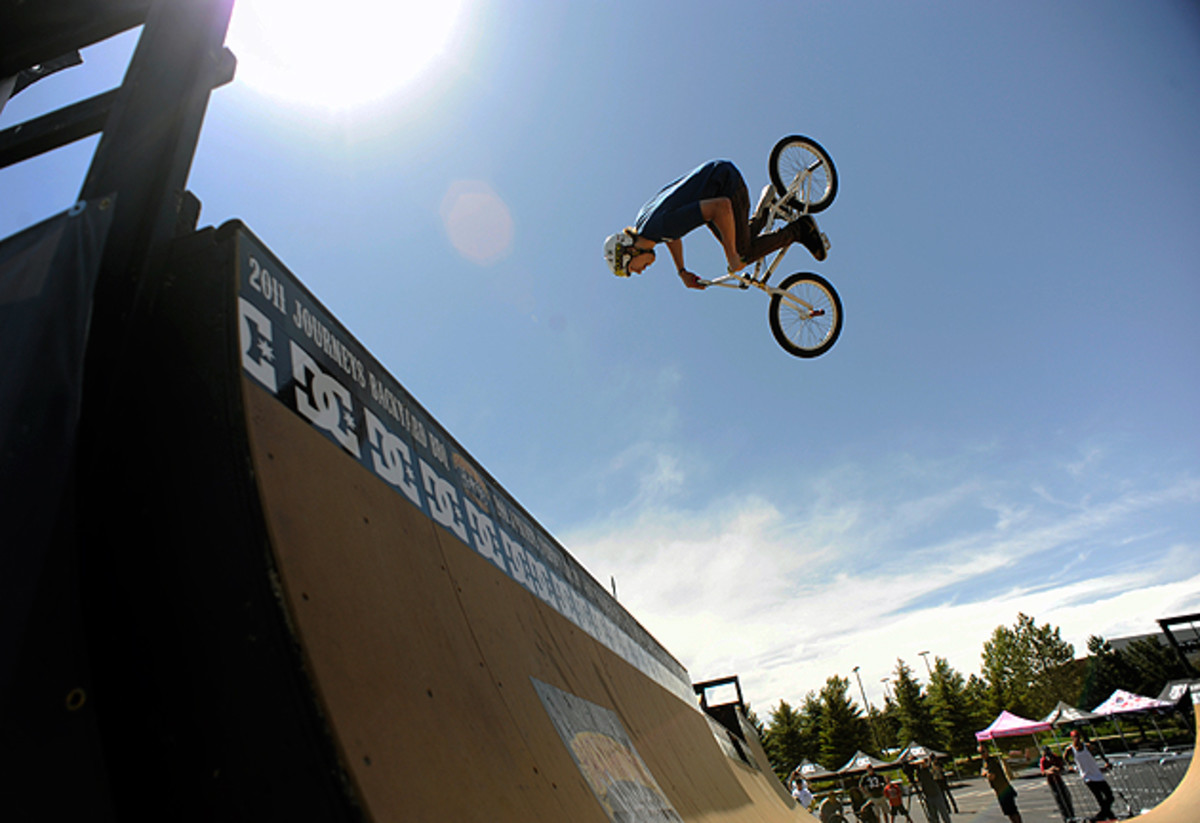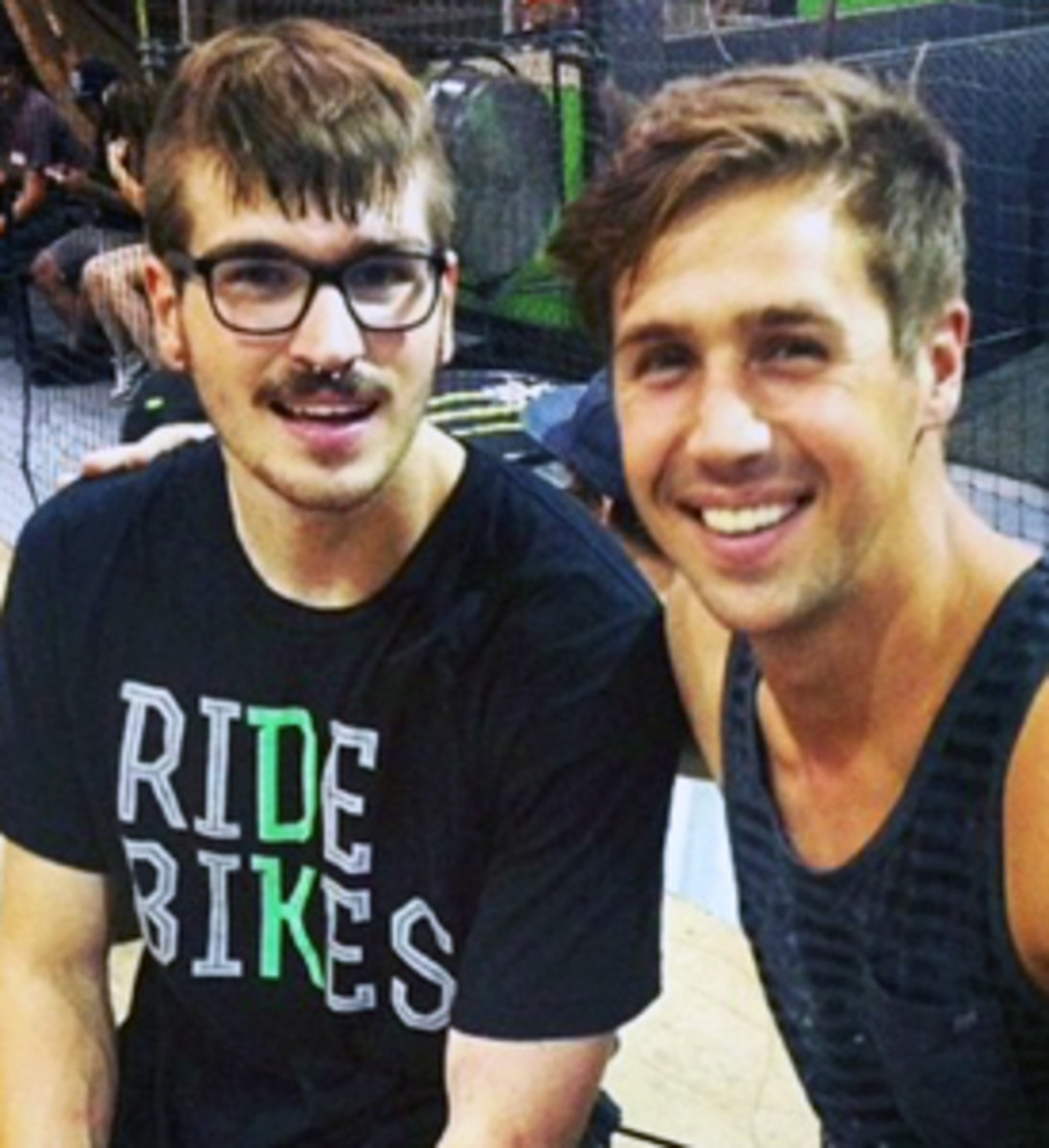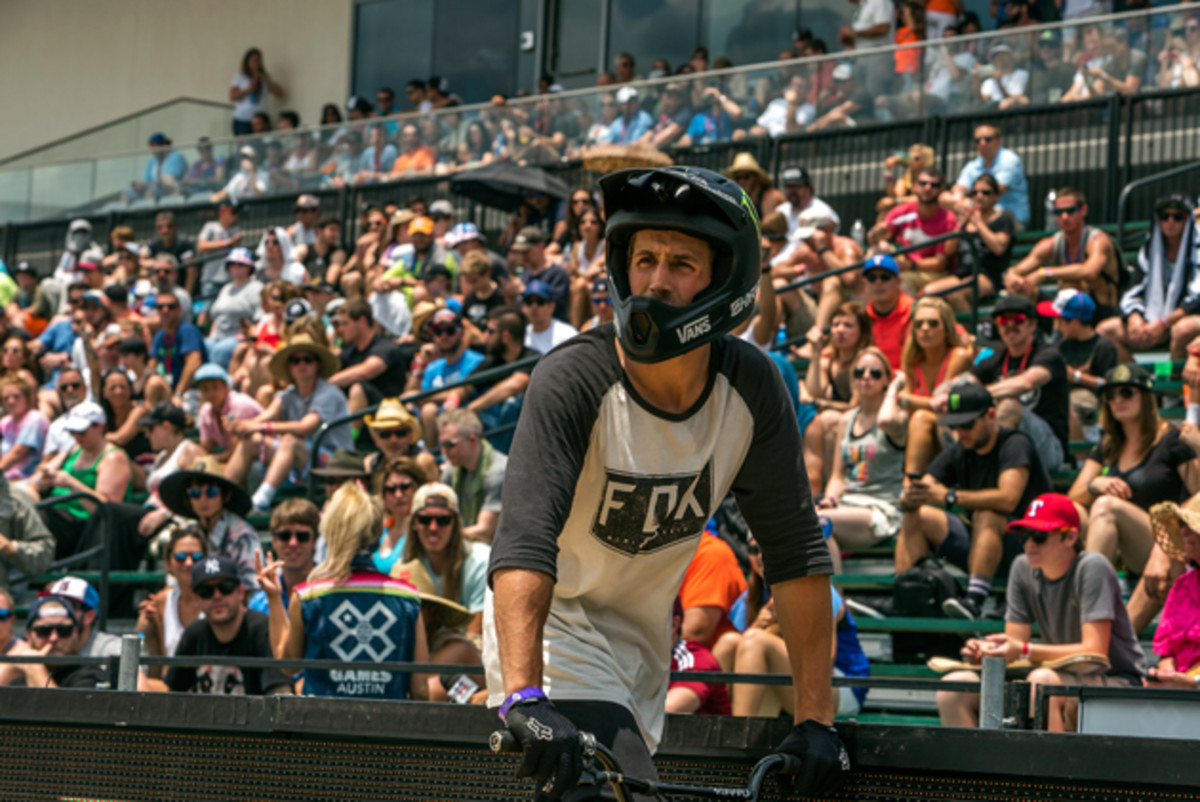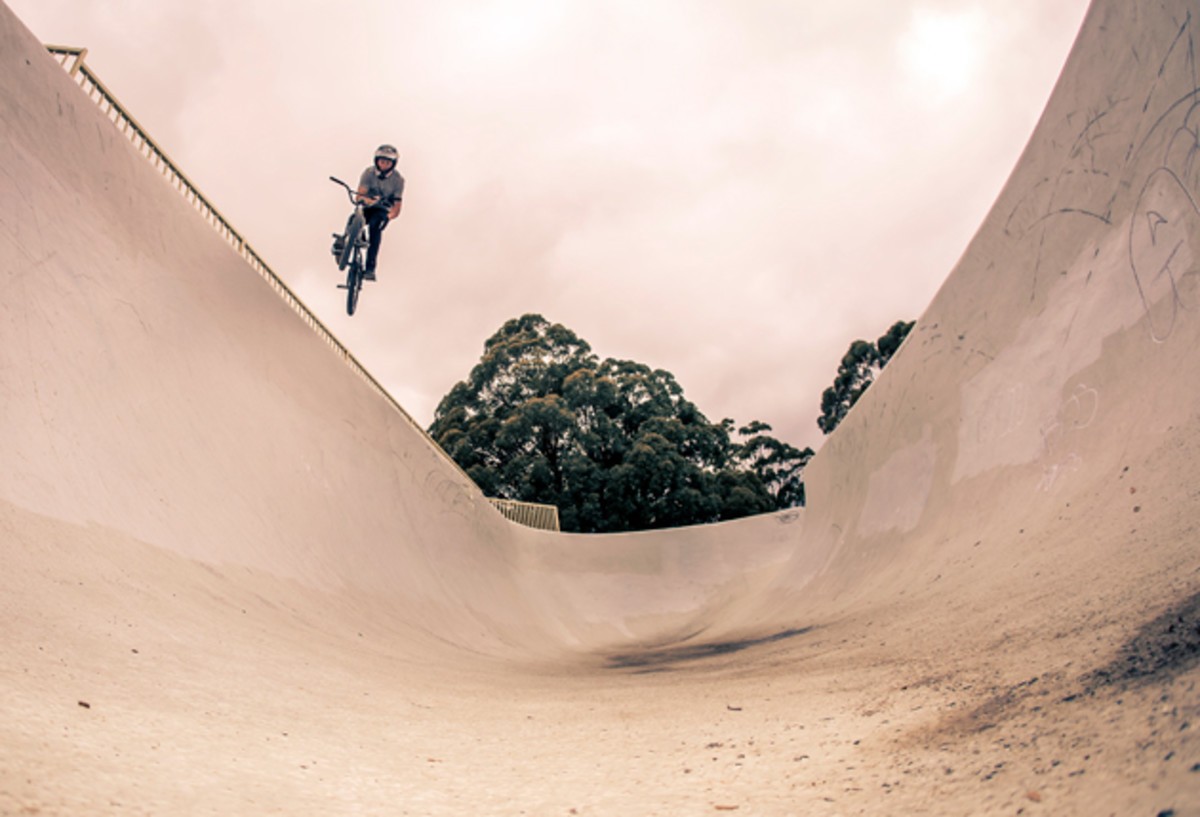BMX rider Scotty Cranmer pushes to make a dangerous sport a little safer

Scotty Cranmer wasn’t sure what happened.
He remembered that he was in second place to Daniel Dhers at the Mountain Dew Tour BMX Park contest in Orlando, Fla. He remembered trying to calm his nerves before his final run. He remembered pedaling as fast as he could to attempt a double backflip—a move he had only tried previously into a foam pit.
The rest was a blur. When Cranmer woke up in the back of the arena, he felt a throbbing pain around his mouth. He had only completed one and half rotations of the flip, landing face first, knocking out his two front teeth.
And this wasn’t the first time.
“I’ve hit my head plenty of times, where you black out for a little bit,” the 28-year-old from Jackson, N.J., admits. He knocked out two other teeth a month prior to the 2006 crash in Orlando.
“It feels like you wake up from a morning sleep,” Cranmer adds. “You think you’re in control but you’re not.”
Yet, despite the countless falls and concussions, Cranmer continued to push the limits of BMX. He won the BMX Park title for the entire Dew Tour in 2011. He took gold in 2009 and at the X Games in 2012. He continued his reign in BMX, and did so wearing a helmet meant for skateboarding.
The choice was a matter of comfort rather than safety. The interior lining of a skateboard helmet is constructed from a softer foam than the stiff expanded polystyrene (EPS) lining of a bike helmet. Skateboard helmets are also not subject to the U.S. Consumer Product Safety Commission’s (CPSC) standards, which require bicycle helmets to pass a series of impact tests.
“At the time we pretty much all wore them,” Cranmer says referring to his fellow BMX riders.
***
It’s Sunday, September 21, 2014, on a cloudy afternoon in Brooklyn, N.Y. The Dew Tour has commandeered three blocks on Franklin Street in front of the House of Vans for its Streetstyle competition. The event features a downhill course composed of jumps, rails, and ledges meant to resemble the urban environment. There’s a jersey barrier. And a park bench. And a Toyota Corolla.
Life after BMX: Dave Mirra's journey to the top of Ironman is underway
“In practice, it looked extremely scary,” Trevor Colden, the skateboard Streetstyle winner, said of the course. “I didn't even want to enter [the contest]. I was like, ‘I don’t know what the hell I am going to do.”
Cranmer was there, waiting. He sat hunched over his bike on top of an industrial-size cargo container, dressed in all black. But Cranmer stands out from his fellow competitors due to his choice in headgear. Instead of the regular skateboarding helmet that he's worn before, Cranmer dons a full-face helmet that looks more at home on the halfpipe or mega ramp than the street course.
When asked at the event why he was the only rider in the field to wear the protective helmet, Cranmer paused and stared at the piece of equipment covered in Monster Energy, FOX, and VANS stickers for few seconds.
“It’s because of Brett,” he said.
***
Cranmer first met Brett Banasiewicz in 2008 when he was practicing for an event in Wisconsin. Banasiewicz traveled three hours from his hometown of South Bend, Ind., to see his favorite pros ride. But the fast-talking 14-year-old with a mop of brown hair wasn’t content just watching. He wanted to grab the attention of his idols and earn their respect.
So he joined in on the session. After landing a maneuver, Banasiewicz would ride up to Cranmer and ask, “Did you see my 720?”
“He was a little pain in the ass just trying to show off,” Cranmer recalls with a laugh. “But you could see right away that he had potential. I knew it was only a matter of time before he was riding with us on a regular basis.”

Banasiewicz turned pro later that year and joined the Dew Tour in 2009. He placed second in BMX Dirt for the Dew Tour series in 2010 and then again in 2011. Banasiewicz no longer had to implore others to watch. The kid with a nose piercing and an endless array of tricks now had the spotlight all to himself.
Although Cranmer and Banasiewicz were competitors, they also became good friends. Cranmer even stayed at Banasiewicz’s house during the summer. The two practiced and honed their moves at the “The Kitchen”—the 333,000 square foot indoor skate park that Banasiewicz had built using some of his contest prize money.
***
Cranmer is ready. He starts his run with a tail-whip drop-in off of the shipping container and picks up speed. He then throws a huge backflip tail-whip off of the next jump. The crowd, swelling three to four deep—gasps. They cheer.
“My strategy was to go out there and go big,” Cranmer said. “Especially when the crowd’s into it you want to put on a good show.”
Out of the 14 riders in Streetstyle, Cranmer is the only one to attempt a backflip tail-whip or a double tail-whip. He soars several feet higher off every obstacle. It’s the kind of riding that looks as though he has no fear. It’s the kind of riding that Banasiewicz loved.
***
After Cranmer won the gold in BMX Park at the 2012 X Games in Los Angeles, he hoped to repeat the performance at the Dew Tour in Ocean City, Maryland.
Banasiewicz had other plans.
Once the 45-second time limit began, he uncorked his entire arsenal of maneuvers. A front-flip, a 270 double tail-whip, a flair-whip, and even a “Cash Roll”—a back-flip variation that is dizzying to watch let alone pull off. Banasiewicz rode like the laws of gravity didn’t apply.
“The Mad Dog is loose and unleashed,” the commentator yelled—evoking Banasiewicz’s nickname.

The run earned Banasiewicz the top spot on the podium. Cranmer settled for third. At 17 years old, Mad Dog became the youngest winner of a Dew Tour event.
“He was flying,” Cranmer recalled. “Coming off that win it was like he was indestructible.”
Everything change two days later on August 23. Banasiewicz crashed during a practice run on a 720 at the LXVI BMX Invitational in Virginia Beach, Va. He fell eight feet and landed on his head.
Banasiewicz suffered a traumatic brain injury and severe vocal cord damage, leaving him in a coma for 15 days.
When he woke up, he couldn’t walk, or speak.
After his father told him the news, Cranmer, who returned home to New Jersey after the Ocean City contest, immediately traveled to Norfolk General Hospital. When he entered Banasiewicz’s room in the trauma center, he saw his friend attached to a ventilator and a feeding tube. There was another a tube sticking out of Banasiewicz’s head to relieve the pressure on his brain.
“It killed me,” Cranmer says.
But it also made him think. About the sport he loves—about its thrills and its dangers. “Every time I ride I am taking risks, but I am calculated,” he says. “I trust myself 100% on my bike. There are certain risks that need to be taken and ones that are unnecessary.”
After visiting Banasiewicz, Cranmer reached out to his sponsor Fox. He wanted a full-face helmet. Cranmer started wearing the Rampage 160 – a model originally designed for mountain bikers.
The Rampage narrowed his vision. It made him claustrophobic. “It sucked wearing that thing the first few times,” Cranmer says, adding that it took him almost two months to regain his comfort and performance level riding with the new helmet.
But Cranmer has something else to add.
“Now, I'll never ride without it,” he says.
[pagebreak]
The recovery process for Banasiewicz has been no easy ride. On September 24, a month after his crash, he was transferred to the Sheperd Center in Atlanta, Georgia, to begin rehabilitation.
Banasiewicz underwent intense physical and speech therapy for over three hours each day. He also received treatment in a hyperbaric oxygen chamber, which circulates pure oxygen to stimulate blood flow. Banasiewicz walked out of the Sheperd Center on November 12. Each step seemed like a hurdle.

In December of 2012, Banasiewicz then went to Dallas, Texas, for outpatient treatment at EXOS Athletes' Performance. Slowly, he improved his mobility, his strength, and his voice.
He also added to his tattoo collection. The newest addition was a lighthouse in clouds with the word "strength" written underneath. The lighthouse is the symbol of Virginia Beach.
"I am here to tell you I am showing the doctors how it is done,” Banasiewicz posted to Facebook while in Dallas. “I was walking at 3 months, said my first words at 3 months, and it's sure not going to take me 2 years to come back!”
On December 27, he was back on his bike.
***
A few months after Banasiewicz’s crash, the Athlete Recovery Fund—an organization that provides financial support for action sports athletes who’ve suffered severe injuries— created a video to raise awareness about the difference between a CPSC-certified helmet and an uncertified helmet.
Banasiewicz was wearing an uncertified helmet when he crashed.
Red Bull turns a BMX rider loose in the ravaged shell of the Silverdome
There was an immediate problem with the test. They couldn’t drop test the non-certified helmet from the typical CPSC elevation of two meters. It would break the machine.
Still, at half the height, the results were jarring. The non-certified helmet experienced 816 G forces. The certified helmet endured 159 G forces. 100 G’s is equivalent to a concussion.
“You would not survive an 800 G hit to the head,” Rob Wesson, the director of helmet creation at Easton-Bell said in the video. “The certified helmet, we came in at 150 G’s. You would stand up and ride away from that. With the other helmet there is no way you could survive that.”
“You would never jump on a motorcycle wearing a bicycle helmet,” ARF President Aaron Cooke said. “Don’t jump on a bicycle wearing an uncertified helmet. It’s that simple.”
Bill and Lisa Banasiewicz, Brett’s parents, joined ARF’s effort and advocated stricter helmet enforcement.
***
Others have heeded the call.
Beginning in 2013, the X Games and Dew Tour required all BMX riders to wear CPSC-certified helmets.
According to Neha Raukar, a sideline physician for the Dew Tour, the X Games also follows the NFL’s protocol and has an independent practitioner evaluate a rider after a crash.
While Dew Tour has been slower to evolve, they have started instituting similar protocols and are studying the injuries to develop the most effective prevention and treatment methods.
The worst crash that Raukar saw was when Kevin Robinson fell on the mega ramp at the X Games in Foz do Iguaçu, Brazil, in April 2013.

Robinson, a nine-time X Games gold medalist and BMX High Air world record holder, landed a backflip over the mega ramp gap, but fell while attempting a no-handed flair on the quarter-pipe. He hit the bottom of the ramp with a thud and was knocked unconscious.
The paramedics stabilized Robinson’s neck and carried him on a spinal board to the ambulance. Robinson gave a thumb’s up to the crowd.
But after a career that spanned over two decades with 42 surgeries and too many concussions to count, Robinson finally decided to walk away.
"I'm done, Robin," Robinson told his wife over the phone the next evening. "I'm ready to retire from competition."
But Robinson, 43, still took his last competitive runs on the mega ramp at the Big Air Finals in August of that year. The thrill of riding was hard to let go.
***
Over the past two and a half years, Banasiewicz’s condition has continued to progress. Each trick he re-learns serves as a milestone. His first front flip into a foam pit on February 26, 2013. His first flair on July 10, 2013.
This June, Banaswieicz, 20, graduated from Washington High School.
He checked off another feat from his list in March, when he competed in the 4th Annual Pro/Am at “The Kitchen.” It was his first pro contest since the crash.
“This will not only be a Pro AM contest of BMX riders, but this will be a celebration of Brett’s miraculous recovery,” Brett’s mother wrote in the press release.
King of the road: Subaru driver David Higgins rules American Rally
“I’m always nervous when I watch him ride,” Cranmer says of Banasiewicz, who’s regained around 25 to 30% of his previous riding ability. “But I just want him to be happy, and he’s the happiest when he’s on his bike. There’s no way to eliminate all risk from our sport.”
While there might be no cure-all, Cranmer’s choice in headgear is a step in the right direction.
“As we learn more about concussions, people are taking it more seriously, but education is the most important factor going forward,” says Raukar, who also co-authored the Institute of Medicine report on sports-related concussion in youth and is a consulting physician for Brown University athletics. “BMX is not as organized as football, it’s not like you have pee wee, so it’s hard to reach out to all these kids and educate them about helmet safety. What Scotty is doing is setting an amazing example and being a role model for both his contemporaries and younger riders.”
***
Cranmer finished his run after grinding down a rail, finally coming to a stop. He took off his helmet and patted it. His score of 90.25 was the highest thus far.
Cranmer completed his next two runs clean, but ultimately had to settle for third place—again. After the contest, though, he seemed less concerned with the result.
“I think it would be really selfish of me to think that I am invincible,” he said when asked about his helmet. “I want to be able to play my piano and guitar and just want to live a normal life. If I have to wear a helmet that is not as cool looking as the rest of the guys, it’s worth it.”
That impact of Cranmer's example has begun to spread, even down to South Bend, Indiana.
Last July, Banasiewicz posted a photo on his twitter account of himself grinding a rail on his bike.
“@scotty cranmer inspired!!!” Banasiewicz wrote.
He was wearing a full-face helmet.
